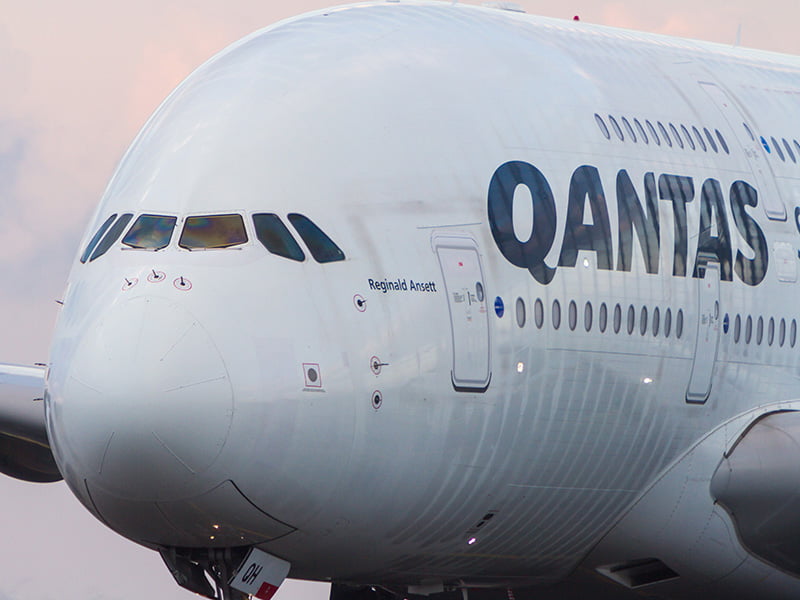A local sustainable aviation fuel industry could be worth $19 billion by 2050, but Australia could lose out to international competition without adequate government support as the global race heats up.
Airbus chief representative for Australia, New Zealand and the Pacific Stephen Forshaw is concerned that Australia is “going to lose the opportunity to be part of the energy transition” without policies to support sustainable aviation fuel (SAF) industry development.
Mr Forshaw, who sits on the Australian Department of Transport’s Jet Zero Council – an aviation emissions reduction policy advisory body – said a SAF-use mandate should be considered in the government’s policy response, a successful policy in the European Union.
He also said the government should fast-track approval for SAF projects and provide additional support for SAF businesses. Consideration should also be given to a “last resort power mechanism” to ensure there is enough biomass retained locally to use as feedstock for a local SAF production industry.
At the end of November, a week after Mr Forshaw spoke to InnovationAus.com, the world’s first transatlantic flight powered entirely by sustainable aviation fuel (SAF) flew from London’s Heathrow Airport to New York’s JFK International Airport. The industry-university consortium received funding from the United Kingdom’s Department of Transport.

The aviation sector contributes to 2.5 per cent of global greenhouse gas emissions and is considered one of the most challenging sectors to reduce emissions in. Electrification or the use of hydrogen fuel cells are not considered feasible options outside of very small aircraft, creating a large expected demand for SAF.
SAF is chemically similar to conventional jet fuel (CIF) but is produced from feedstocks that can be replenished.
When including the production of biomass feedstock such as oilseeds and sugarcane, SAF can reduce fuel life cycle emissions between 60-100 per cent compared to CIF according to the International Aviation Organisation, according to an industry roadmap by CSIRO and Boeing – both represented on the Jet Zero Council.
The roadmap estimates that Australia has enough resources to produce almost five billion litres of SAF by 2025, potentially meeting 60 per cent of projected jet fuel demand.
Australia already produces and exports large amounts of oilseeds and sugar, as well as processed animal fat and used cooking oil. It is also a major exporter of canola seed to the European Union, where it is processed into biofuels.
However, the SAF industry is nascent with just 0.01 per cent of global jet fuel needs met by SAF, of which none is produced in Australia, according to Mr Forshaw.
While “[SAF] production at scale in Australia is still going to be some years off” if policy decisions aren’t made now, Australia will end up exporting its abundant supply of SAF feedstock to other jurisdictions, according to Mr Forshaw.
“You’re seeing very supportive policies in the US and in Europe that support the production of sustainable aviation fuels. In the US, in particular the inflation Reduction Act has generated huge subsidies for the generation of new sustainable fuels, and SAF is one of those,” Mr Forshaw told InnovationAus.com.
He also highlighted the European Union’s sustainable aviation fuel mandate, passed in April. From 2025, airport fuel suppliers are required to ensure SAF makes up two per cent of fuel supplied. This target will increase periodically before reaching 70 per cent by 2050.
The UK government is currently finalising its own SAF mandate after announcing in its 2021 Net Zero Strategy a target to have 10 per cent of UK jet fuel come from SAF.
Mr Forshaw said this is the type of “policy backing” drives the development of SAF production infrastructure and capability. He argues this partly explains the growth of Finland-based Neste, which has claimed to be the world’s largest SAF producer.
“They’re scaling up and they’re also looking to build production in Asia as well. If you think about it, the mandate requires production to occur to be able to meet the target for use,” he said.
“I think one of the things that we’re very keen to look at in Australia is whether a mandate policy requiring use of SAF could actually be part of the mix and, much like it has in Europe, it does provide them the opportunity to catalyse industry.”
He also argued that since Australia is the world’s ninth largest consumer of jet fuel, it would be unlikely to be economically or environmentally sustainable to meet a mandated use target by imports exclusively.
Qantas, also a Jet Zero Council member, has announced it would target 10 per cent SAF use by 2030 and approximately 60 per cent by 2050. To help meets its target, the airliner is jointly committed to investing US$200 million (AU$301 million) after it signed an Australian Sustainable Aviation Fuel Partnership with Airbus in June 2022.
Qantas has also signed a memorandum of understanding with the Queensland government to support the state’s ambition “to be an Asia-Pacific green jet fuel hub on the runway”.
Mr Forshaw closed his comments to InnovationAus.com with a hint of urgent optimism.
“I’m confident that we can see meaningful levels of production in Australia well before 2030 if we have the right policy settings that are going to encourage the investment, because the feasibility shows us that it can be there, feedstock is there now,” he said.
“But if we don’t do something to start production soon and we start losing feedstock to export then, then there are potential threats to our ability to be to be able to scale to meaningful production.”







